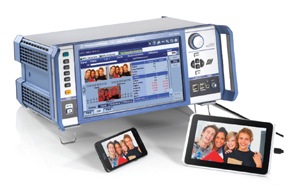Video Test & Measurement in the Cellular Era
ALEXANDRIA, VA.—It should be obvious by now that lots of people view videos on their cellphones and tablets. In fact, the major cellular providers all have entertainment packages that feed network and original television programs to their customers—for a fee, of course. According to Cisco, 1.2 million minutes of video content will cross global IP networks every second by 2016.

Rohde & Schwarz Video Tester This mobile audience is only going to grow, so now is the time to start thinking about the quality of what they watch. As it happens, manufacturers of test gear have also been tracking this trend and have products to address the creation of content for distribution on cell phones and tablets.
“As a kid, I remember well the static on our analog TV set every time my mom used her electric mixer or hair dryer,” said Danny Wilson, CEO and president of Pixelmetrix. “Digital is no different: Transmission problems with ATSC, rain fade on satellite and noise on the cable system all lead to packet loss, which in turn leads to poor television.” Wilson said there is a fundamental difference between that delivery mode and the one used in cellular devices.
“Over-the-top (OTT) video used by cellular devices doesn’t lose packets,” he said. “Being ‘just a web server,’ OTT devices use HTTP just like any web client. And HTTP is built on TCP, which doesn’t lose data. This means all the traditional measurements for television just don’t apply to OTT. Measurements like packet loss and jitter are meaningless.”
Just like it is with broadcast ATSC video and any familiar delivery medium, getting great video to cellular users starts with creating great video.

Sudeep Bose, segment strategy & business development manager for file-based solutions for Tektronix “As with traditional broadcast video, the tenet of ‘garbage in, garbage out’ applies to mobile and OTT video workflows,” said Sudeep Bose, segment strategy & business development manager for file-based solutions for Tektronix. “As such, the mobile and OTT video service provider [VSP] has to ensure that the source content is of relatively high resolution and bitrate, as all the variants created for mobile and OTT delivery will compress these. These source content files must be devoid of any audio and video artifacts such as blockiness, blurriness, inadvertent black frames, pixelization, audio dropouts and phase issues.”
ALL OVER THE MAP
Looking just at the displays on mobile devices, the native resolution of the displays is all over the map. Many popular cellphones have 480x800-pixel resolution, some newer ones have 540x960-pixel screens (which map well to 16:9 aspect ratio playbacks) and the wildly successful iPhone 4 and 4S have display resolution of 640x960 pixels. The iPhone 5 has a display of 1,136x640 pixels and a 16:9 aspect ratio. Many cell phones have less resolution, and tablets are likewise fitted with displays that have a very wide range of resolutions.
The professional video industry's #1 source for news, trends and product and tech information. Sign up below.
Likewise, the cellular networks feeding these devices have widely variable bit rates, depending on the device’s design, overall network configuration and congestion, the viewer’s location and RF propagation variabilities.
“The video encoding has to be done for both the target device and typical delivery speeds available,” Wilson said. “Since the broadcaster is not in control of the transmission link, research into the possible range of bit rates must be done. Mobile data rates across the U.S. vary considerably, and degrade in the presence of interference or congestion. Therefore, in planning an OTT service, not only the minimum/maximum bitrate range must be decided, but also how many different speeds [profiles] should be implemented.”
Encoding is a point of great importance to deliver the best video experience to viewers.
“Each of these encoded bit rate variant files must be encoded in a way that the IDR [instantaneous decoder refresh] frames fall in a particular point in the GOP of the transcoded file, such that once that transcoded file is fragmented for ABR delivery, those IDR frames are the first frame in each ‘chunk’ of the fragmented content,” Bose said. “This is one of the most fundamental and workflowspecific needs for mobile and OTT video.”
ADDRESSING CONCERNS
All that said, there are a variety of approaches taken by test equipment manufacturers to address the concerns of cellular video delivery. The Rohde & Schwarz Video Testers are part of a family of products to analyze digital video.
“The new Video Testers are versatile instruments designed for audio/video interface tesing [HDMI, MHL] on smartphones and tables,” said Harald Gsoedl, manager of product marketing for broadcast test & measurement for Rohde & Schwarz. “They allow detailed analysis of the video and audio content that is received and decoded on the mobile devices.”
The Rohde & Schwarz Video Testers can also be used in conjunction with a radio communication tester to analyze the RF link to the cellular device.

Screenshot from a Tektronix Cerify
VideoClarity’s Real Time Monitoring (RTM) analyzer has integrated IP receiving/ decoding and can monitor IP video and OTT traffic. RTM has automatic scaling of reference feed to the size and frame-rate of the IP feed, making it capable of working with a variety of display resolutions and bitrates.
Pixelmetrix specializes in testing the network to see how it can handle the stress of constantly changing demand and viewing patterns.
“After looking at the significant differences between OTT and traditional television, we have developed seven key metrics for OTT service performance,” Wilson said. “Called VideoMargin, these metrics evaluate overall system performance as well as the performance of the various mid-way components. Our first product, the OTT Media Grinder [OMG], is a client simulator that imitates thousands of OTT clients and creates a report of overall service availability, as well as detailed reports on the various metrics.”
In addition, Wilson said that Pixelmetrix is planning to roll out additional products based on VideoMargin metrics that will test and monitor other, more focused, parts of the delivery chain.
Tektronix has multiple test devices to address the needs of mobile content developers.
“During the early stages of the workflow build, VSPs can use the Picture Quality Analysis [PQA] product to select the encoder and transcoder that best fits their design and budget needs,” Bose said. “Once the workflow is in operation, the Cerify product is used to ensure the quality and compliance of the A/V content as it enters these workflows. At this stage, the content is checked for quality as well as for compliance to technical specification [such as color, gamut and luminence], as well as regulatory compliance for audio loudness, captions, and even tests to ensure that the content will not trigger photosensitive epilepsy.”
In addition, the Tektronix Sentry will test the output quality of the master encoders in realtime. Sentry can monitor up to 250 video/audio streams simultaneously for video encoding quality, video bit rate, audio encoding quality, audio bit rate, and can provide metrics for the viewer’s Quality of Experience (QoE).
DIFFERENT CHALLENGES
Although there is considerable experience in delivering video as files over wired IP networks, the wireless domain has some challenges different from wired delivery.
“IT folks, noting that OTT is built on a web server, have suggested managing OTT like a normal website; by looking at the server log files,” Wilson said. “While it is true this will give you information about missing files and server errors, HTTP analysis alone is not enough—it does not give you enough information about the television service quality. Clearly, new metrics are needed.”
Tektronix’s Bose agrees that some of this approaches the video equivalent of a “Brave New World.”
“Many VSPs have established early beachheads to get in the game but are still evolving their workflow designs,” he said. “Technologies and vendors are changing continually, such as Adobe Flash exiting the market while MPEG DASH is joining the fray, to name some recent notable market changes. The growth in the number of OTT VSPs even in the past year is a key indicator of the vitality of this segment. As such, there is a lot to learn, know and discuss, which will not go away any time soon.”
We’ve come a long way from needing only a waveform monitor and a vectorscope. As cellular customers demand increasing amounts of video, they will be watching on displays completely different from those used to create the content.
Those customers are paying for content, and they have a reasonable expectation to view it in as high a quality as their device and cellular network will permit. Smart content providers will consider this as they prepare programming for these viewers.
Bob Kovacs is the former Technology Editor for TV Tech and editor of Government Video. He is a long-time video engineer and writer, who now works as a video producer for a government agency. In 2020, Kovacs won several awards as the editor and co-producer of the short film "Rendezvous."

